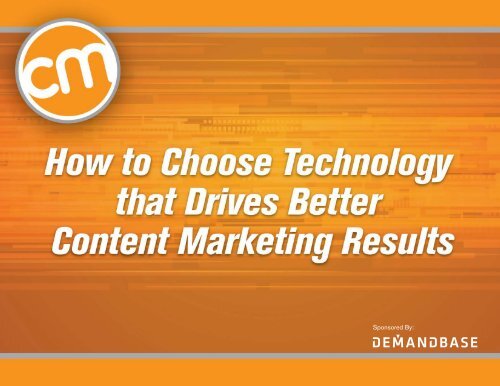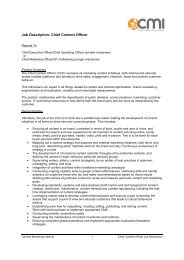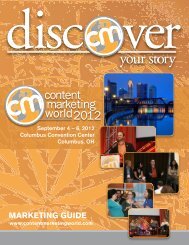Download Now - Content Marketing Institute
Download Now - Content Marketing Institute
Download Now - Content Marketing Institute
Create successful ePaper yourself
Turn your PDF publications into a flip-book with our unique Google optimized e-Paper software.
Sponsored By:
<strong>Content</strong> Management Systems (CMS)Corporate WebsitesDisplay Advertising NetworksPPC AdvertisingPrint PublicationsLive EventsVirtual EventsBlogging Platforms<strong>Content</strong> SyndicationVideoSocial MediaWant to see some ofthe key providers foreach of these contenttechnologies?CLICK HERE forCMI’s Vendor List.InquiriesINQUIRIESEarly sales and marketing funnel stage,characterized by a growing awareness ofyour solutions or products.PULL CONTENTMQL-SALMQL - SALPUSH CONTENTPersonalizationMiddle of the marketing funnel stage,characterized by an existing awareness ofyour solutions or products.MQL - <strong>Marketing</strong> Qualified LeadSAL - Sales Accepted Lead<strong>Marketing</strong> AutomationDirect MailPodcastingWebinar/Webcast PlatformsEmail Service ProvidersField <strong>Marketing</strong> EventsSQL-PIPELINEP2P CONTENTCRMOnline Meeting/Screen SharingDesktop Email<strong>Marketing</strong> Automation Systems for SalesSQL-PipelineBottom of the marketing funnel stage, whereleads are no longer owned by marketing andthe salespeople take control of sharingcontent with their customers.SQL - Sales Qualified LeadPipeline - Engaged in the Sales Cycle
How to Choose Technology that Drives Better <strong>Content</strong> <strong>Marketing</strong> ResultsHow Does Technology Impact <strong>Content</strong> Strategy?Self-empowered buyers increasingly educate themselves before reaching out to solution vendors. According to Adam Needles,marketers need to understand these buyers’ channel and content preferences to deliver a holistic set of content throughout thebuying cycle.But the delivery piece is not that simple, especially for B2B organizations trying to reach and engage multiple stakeholders — eachwith distinct interests and challenges — at different stages of the buying journey. In fact, trying to put the right content in the hands ofprospects at precisely the right moment is incredibly difficult without the help of technology.Streamline and enhance processesUsing technology, organizations can deliver relevant content at every stage in an automated fashion. From awareness, branding,and consideration all the way through to purchase, follow up, service, and cross-selling and up-selling, technologycan streamline and enhance the processes associated with parceling out content. And this is particularly important fororganizations with distributed or global workforces contributing to content creation and dissemination, says Rebecca Lieb.In fact, Jonathan Block underscores the fact that marketers can use technology to:• Align content with the buying cycle• Reach prospects faster and more effectively• Make sense of all the data they collect about prospective buyersBetter understand prospectsDavid Raab highlights the fact that tools like those from Demandbase provide marketers with data that they don’t normally get untilprospects have shared more about themselves. Instead of inferring or asking someone to fill out a survey or registration form, tools canprovide this information.5
How to Choose Technology that Drives Better <strong>Content</strong> <strong>Marketing</strong> ResultsWhy Take an Integrated Approach?Organizations risk missing numerous opportunities by not taking a holistic approach to theiruse of technology. As John Neeson reminds us, B2B marketers are no longer marketing aspecific activity like an event or white paper. Rather, they are marketing to the complete buyer’sjourney, integrating all their marketing efforts in a unified manner to align with specific needsthroughout the decision-making process. This approach requires a very different mindset; namely,organizations need to better understand where buyers go for information and how they consume it.Unfortunately, many marketers adopt a siloed view of the various tactics at their disposal. Butas Carlos Hidalgo points out, an integrated approach is vital. After all, a one-medium approachgrows stale and becomes subjected to the law of diminishing returns. In other words,marketers that rely solely on email, telemarketing, or direct mail often struggle tomaintain their prospective buyers’ interest over time.Three MissedOpportunities Dueto Lack of Integration• Reach• Deeper level of engagement• Sales productivity- Mike Vannoy, COO,Sales Engine InternationalKeep buyers moving through the funnelAn integrated — or multi-channel — approach, on the other hand, enables buyers to interactwith an organization in numerous ways and choose the ones that best serve them at anygiven point. Carlos Hidalgo shares the wisdom of Joe Chernov, VP of <strong>Content</strong> for Eloqua,who says that marketers are fighting for buyers’ attention, rather than their time. With that inmind, a mix of content (for example, video, email, social media, infographics, andwebinars) delivered via numerous channels is a better way to capture the attentionof buyers and keep them moving through the demand generation funnel.Drive process stewardshipAdam Needles suggests marketers should strive to drive process stewardship of interactionswith buyers across the entire lead-to-revenue process. Achieving this goal requires anintegrated view of the process, including continuity of dialogue across channels and buyingstages, lead qualification, and ownership by sales and marketing.6
How to Choose Technology that Drives Better <strong>Content</strong> <strong>Marketing</strong> ResultsKeep the customer’s experience in mindDavid Raab suggests starting by documenting the customer engagement strategy, specifically the processes through which the organizationneeds to walk a prospective buyer. As Carlos Hidalgo points out, most B2B organizations are selling to multiple buyers within targetaccounts and it’s vital to develop an understanding of their roles, functions, challenges, and the triggers that move them towards a buyingdecision. Without this understanding, any technology could, potentially, be the wrong technology since it will not get marketers any closerto a meaningful connection with prospects.Account for data continuityAccording to Adam Needles, it’s critical to determine what it takes to ensure continuity of the information associated with prospective buyers— including their lead status — as the data follow the prospect from stage to stage. Without this mapping, organizations will fail to tapinto all the data they’re collecting.First, break the process down by stages in the buying (or selling) cycle and by the content to be delivered at eachstage. Next, determine the data that need to be added and passed on at each stage to effectively engage, nurture,and convert prospects. Don’t forget to outline what downstream processes, such as lead handoff, look like from thesales perspective. By thinking through the step-by-step process, marketers will understand what’s needed to ensurecontinuity from beginning to end while avoiding adding complexity.Consider:• What’s your business?• What’s your product or service?• Who are your customers?• What does the buying/sales cycle look like?• What systems are in place for data sources (CRM, marketing automation, web analytics, etc.)?• What’s the size of your data stores, number of customers, and quantity of process workflows?8
How to Choose Technology that Drives Better <strong>Content</strong> <strong>Marketing</strong> ResultsMake a shortlist of potential solutionsNarrow down the list of vendors that can help solve the organization’s businessissues before bringing in IT. While the ultimate decision comes down to how wellthe solution supports the organization’s processes, required budget and in-houseskills and sophistication also come into play.Consider free or low-cost solutionsRebecca Lieb advises organizations just experimenting with content marketing toconsider free or low-cost solutions, such as Twitter, Facebook, WordPress, andGoogle Analytics. That said, she warns that they shouldn’t get fooled into thinkingcontent marketing is free as a result. <strong>Content</strong> marketing does have costs in termsof salaries and the resources needed to create and publish content, moderaterelated conversations, and measure the impact. And no technology, regardless ofprice, can succeed in a vacuum. Google Analytics will provide mountains of data,but without resources dedicated to parsing, analyzing and acting on it, the value ofthe tool diminishes.Don’t Get Distractedby Shiny ObjectsIt’s critical to prioritize when considering solutions.For example, though a tool may look slick, it’s notworth the investment if it will only apply to a smallportion of a process. Determine how much businessany given tool can impact. – David RaabTap into IT’s expertiseThe IT group can lend expertise from a vendor evaluation perspective, suchas by determining how well the tools in question integrate with the existingIT landscape. Jonathan Block highlights the need to understand just how theintegration happens. For example, does the vendor handle it, or does a partnerneed to get involved?Keep your options openRebecca Lieb says the one word marketers should keep in mind during thetechnology selection process is open. Technology should be modular and easilyintegrate with future as questions about integrations are just as important as theones about features and benefits. It’s also important to understand the processfor migrating from the tool under consideration to another one in the future.10
How to Choose Technology that Drives Better <strong>Content</strong> <strong>Marketing</strong> ResultsJustifying the PurchaseTo secure buy-in for the purchase, most marketers will need to justify theinvestment. One option is to present both the cost and estimated amount ofincremental business the solution can possibly help generate, such as by sharingvendor case studies and surveys from industry analysts.Determine what’s at stakeAccording to David Raab, the real investment is the opportunity cost. In other words,what could staff be working on if they weren’t bogged down by repetitive, manualtasks? As a result, the business case is often less formal — marketers know theyneed to more efficiently and effectively interact with prospects and may be unableto so without adding these tools.The key is figuring out the value if, for example, a tool will help boostthe response rate of nurture programs by 10%. If marketers are making thecase to dedicate resources to inbound marketing, they should compare the coststo what is spent on outbound marketing. Or if 80% of inquires do not receive theproper follow-up, how much money was spent — and wasted — generating thoseinquiries? If properly managed, how many of those inquiries would have convertedto a sale, and how much does that equate to in revenue? As Carlos Hidalgo pointsout, a properly defined process combined with an enabling technology can closethose “leaks” and makes for a very compelling business case. In other words, themost valuable inquiries become worthless if a lead capture form is broken or if themechanism that delivers the content misfires.Make It anOpen-and-Shut CaseTrying to prove ROI before you’ve made theinvestment is a fool’s errand. You can makethe numbers work out however you’d like. It’sabout building the business case, not provingROI. – Robert RoseThe business case starts with the lost revenue orrevenue that is being left on the table by nothaving the right process and right enablingtechnologies. – Carlos HidalgoBe sure to spell out why it’s necessary to apply a specific solution to the challengeat hand. For example, does the scale of the company’s business demand asophisticated marketing automation system versus a more basic email system?11
How to Choose Technology that Drives Better <strong>Content</strong> <strong>Marketing</strong> ResultsModel the ROI of integrated technologiesWhile marketers often need to sell the vision and make a persuasive argumentrather than project the anticipated payback of such an investment, the CFO mightdemand an ROI spreadsheet. In those cases, consider the following options:• Present the pros and cons of going with a best-of-breed approach versusan integrated suite, and underscore the anticipatedROI of the preferred solution.• Collect conversion rates from beginning to end of the demand creationwaterfall or sales funnel to demonstrate the potential impactof using technologies to plug the leaks and increase conversions.• Determine Key Performance Indicators (KPIs) — such as number of contentdownloads and contribution to revenues — and model how the technologieswill help improve the KPIs.How to Get C-Level Sign-OffsFocus on process and business goals to drivejustification for the purchase – that’s the languagethe CTO and CFO understand. – Jonathan BlockIn Carlos Hidalgo’s experience, once the case is presented, it changes thediscussion from “Should we?” to “Why wouldn’t we?” He also feels it givesmarketers insight into where they stand. If an organization won’t invest in thetechnologies needed to secure better buyer engagement and higher revenues, itmay be time to start looking for a new role in another company.12
How to Choose Technology that Drives Better <strong>Content</strong> <strong>Marketing</strong> ResultsConclusion: Plan for SuccessSavvy marketers are adopting a content marketing mindset and defining a strategyto help their organizations connect with empowered, self-educating buyersthroughout the buying cycle. But for companies trying to attract and engage multiplestakeholders over a lengthy time frame, failure is almost certain without the useof technologies that automate the delivery of some or most content. That said,marketers are best served by thinking strategically when evaluating, selecting, andjustifying needed tools.Just as B2B customers go through a certain set of stages when considering apurchase, B2B marketers do the same. Follow these steps for a strategic approachto using technology:❑ Define a content marketing strategy❑ Document associated needs from a people and process perspective❑ Assess solutions that help address these needs❑ Create a shortlist and engage IT for evaluation❑ Make the business case❑ Plan, implement, and execute❑ Repeat the cycle to improveThe Typical Process forSelecting Technology Tools1. Decide and buy2. Implement and integrate3. Manage and maintain4. Upgrade and enhanceKeep Change Top of MindThe purchase of marketing technologies tosupport processes is about a change in thinking andoperations. Change takes time if it is going tobe made permanent. Be patient, go for some quickwins and evangelize the wins as you go.– Carlos HidalgoPersonalization Tools from DemandbaseAccount-based targeting and personalization of content forms and offers hasbecome a key component to increasing web engagement and converting more ofthe prospects visiting B2B websites. For more information about Demandbase, orto request a complimentary audit of the forms or content offerings on your B2Bwebsite, please go to www.demandbase.com/techguide.13
Essential <strong>Content</strong> <strong>Marketing</strong> ResourcesChief <strong>Content</strong> Officer magazineCCO magazine is the leading print and digitalmagazine dedicated to content marketing strategyfor marketing executives. CCO is free to qualifiedsubscribers. Sign up here.2012 B2B <strong>Content</strong> <strong>Marketing</strong>Research ReportHere’s the full report on many of the contentmarketing statistics found in this white paper.<strong>Download</strong> the report free today!Get <strong>Content</strong>. Get CustomersCalled “The Handbook for <strong>Content</strong> <strong>Marketing</strong>”,Get <strong>Content</strong>. Get Customers. teachesorganizations how to use content marketingto deliver relevant, valuable and compellinginformation that turns prospects into buyers.Available now at Amazon.com.<strong>Content</strong> <strong>Marketing</strong> PlaybookYou want content distribution options?You got it. Here are 42 contentdistribution tactics and over 50 casestudies from companies doing contentmarketing right. <strong>Download</strong> the fullguide today.Managing <strong>Content</strong> <strong>Marketing</strong>The follow-up book to Get <strong>Content</strong> GetCustomers, but focuses on how to manageand structure content marketing inside theorganization. A must read for anyone who “gets”content marketing and needs to execute contentprograms. Available now at Amazon.com.<strong>Content</strong> <strong>Marketing</strong> WorldTHE premier annual event for content marketing, where thousands ofcontent marketers come together in one location from around the world.Find out more about CM World today!Tell Them What They Want to Hear:Optimizing the BtoB Web Site withAccount-Based Targeted <strong>Content</strong>This eBook offers strategies to address the unique needs of yourB2B customer by implementing strategies such as adapting yourcontent strategy to address your buyer directly and intelligently ontopics that generate the most interest. Click Here.Nailing the Landing: Four Steps For OptimizingLanding Pages and Forms To Improve ConversionsYou created some great content … now don’t forget the landingpage. This white paper features the latest on how to optimize yourcampaign landing pages and improve your form conversion rates.Click Here.





